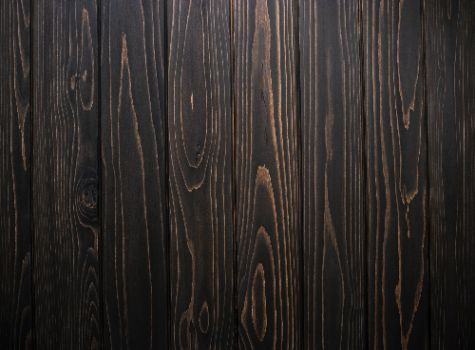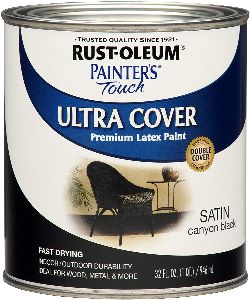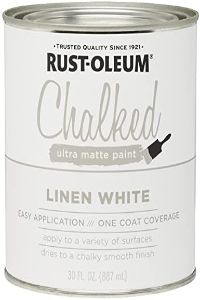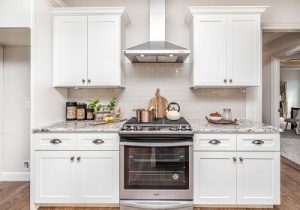There are several types of paint finishes. Choosing the proper one for your particular project requires some basic knowledge about each of them.
You need to know what makes each finish unique and weigh its pros and cons to make the best choice. This article will discuss Satin vs. Matte Paint Finish to get you started.
The main distinction between satin and matte paints is their sheen. Sheen is the amount of light reflecting off the paint’s surface after it dries. Matte paints reflect no light; therefore, they do not have a noticeable shine.
They exhibit the paint’s actual color since there is no impact from light. Furthermore, the little light reflection will not draw too much attention to your surface; therefore, you can use matte paints on flawed surfaces, and the imperfections won’t show.
On the other hand, satin paints reflect just a bit of light – about 30% – creating a gentle glow after the paint dries. The slight light reflection causes their color to look more intense than matte paints with the same color.
On the downside, satin paints tend to highlight surface imperfections, so you must always apply them carefully. Prepare your surfaces thoroughly and use appropriate painting techniques.
Understanding Paint Sheen
 Paint has three main ingredients – pigment, resin, and a solvent. The pigment provides the paint’s color, while the resin/binder is the “glue” that holds the pigment particles together on the surface.
Paint has three main ingredients – pigment, resin, and a solvent. The pigment provides the paint’s color, while the resin/binder is the “glue” that holds the pigment particles together on the surface.
Both pigments and resins are solids, so manufacturers suspend them in a solvent to make it easier to transfer them from the paint container to the surface.
The ratio of resins to pigments determines the sheen level in a paint. Products with more resins and low Pigment Volume Concentration (PVC) reflect a lot of light after they cure; therefore, the finish appears shiny.
Moreover, due to the low amount of pigment, their colors are less intense, so you may have to apply several coats to achieve good coverage.
On the other hand, products with high PVC and low resin ratios reflect very little to no light. As a result, they have a fuller appearance when dry. On the bright side, the higher pigment ratios make these paints more opaque; hence you can cover surfaces fully with as little as one coat.
What Is Satin Paint Finish
Satin paint finishes are part of the gloss paint products, but they are at the lowest end of the spectrum. Paints with a satin finish have more resins than pigments; however, the resin ratio doesn’t surpass the pigment ratio by a great deal. Therefore they reflect very little light.Â
When you touch a satin paint finish, it has the chalky feel of a low gloss finish. At the same time, it has a subtle silky smoothness like a slightly waxed surface.
The soft sheen of satin paint allows it to hide bumps and surface imperfections better than other shiny finishes. Its pigment ratio isn’t too low either; therefore, it covers stains adequately.
The higher resin ratio in satin paints makes them more resilient; thus, they last longer than low sheen products. Moreover, they can withstand consistent cleaning, so you can wipe the paint coat daily or hose it down with a pipe without the risk of the sheen reducing. Â
Because of the resilience and ease of cleaning, satin finishes are perfect for high and low traffic areas. You can use them on interior walls like the living room or your kid’s bedroom. You can also use satin paints on window sills and trim.
Pros and Cons of Satin Paint Finish

Pros
- The higher resin ratio makes them resilient hence they are durable.
- They reflect some light, but they still have the coverage advantages of low sheen finishes.
- Satin finishes are easy to clean.Â
Cons
- Even though they reflect little light, satin finishes can still highlight ou lack proper painting skills.
What Is Matte Paint Finish?
A matte paint finish is a finish with the lowest gloss percentage. It has a low resin-pigment ratio; therefore, it reflects very little light when dry.
A matte finish appears velvety because of the higher pigment ratio. However, its surface feels a bit rough and chalky when you brush your hand over it.
Due to its low light reflection, a matte paint finish doesn’t draw too much attention to the painted surface. Therefore, you can use it on a surface with imperfections, and it will hide the bumps perfectly.
You may be able to tell where the flaws are if you knew where they were before painting. However, it is usually hard to tell, especially if you follow all the necessary painting procedures.
On the downside, the low resin ratio in matte paints makes them less resilient to harsh weather and other mechanical forces. As a result, they do not last on pieces that you keep outside or pieces in moisture-prone areas.
It is easy to get stains on a matte paint coat, but you risk removing the paint when you try to remove them. This type of finish is tough to clean, and it doesn’t help that it attracts the most dirt.
When trying to remove stains, the constant rubbing motions will scratch off some of the paint, and if you scour too hard, you risk scratching off the paint.
Since they get dirty fast and you can’t clean them freely, it is better to use matte paint finishes on low-traffic areas and furniture pieces that don’t get much use. You can use them on ceilings, adult bedroom walls, and furniture that you only use to decorate your space.
Pros and Cons of Matte Paint Finish
 Pros
Pros
- Matte finishes are thicker, so they self-level as you paint hence reducing the chances of leaving lap marks on the coatÂ
- Gives surfaces a sleek modern look without too much shine.
- Hides surface imperfections well due to low light reflection.
- Dries quicker than glossy finishes.
Cons
- It is difficult to remove stains and spills without ruining the finish.
- The finish gets chalky quickly if you use it outside or in high traffic areasÂ
- You have to do regular retouches to keep the finish beautiful.
Satin Vs Matte Paint FinishÂ
Knowing the individual characteristics of satin and matte finishes helps. However, it is better to compare specific major factors directly, especially when choosing one or the other for a project.
The following is a deeper look into how each finish stands out. I’ll compare everything from appearance to the best places to use each and why.
-
Appearance
Matte and satin finishes appear almost similar, but the main distinguishing factor is light reflection. A satin paint finish reflects some light, emitting a slight glow. In contrast, a matte finish has no sheen at all.
It does not reflect light even if you shine a light directly on the painted surface.
Since a satin finish reflects some light, the light hitting its surface always influences its color – especially if it bounces off another object with a different color.
This characteristic often causes the paint to look lighter or darker depending on the conditions. Sometimes, when a differently colored surface is near a satin-finished wall or furniture piece, you will notice visual color variations on the finish.
In contrast, the non-reflective surface of matte allows it to keep its actual color in all surroundings. However, the lack of sheen also means that a matte finish does not have the same visual depth as a satin finish.
Sometimes the lack of depth can be ideal, but it can also make the color seem too overwhelming, especially in small areas like hallways.
-
Finish
Satin and matte finishes may have different sheen levels, but they always look smooth once applied. Satin paint has a slightly chalky appearance, but it feels silky like a waxed surface. On the other hand, matte colors have a more chalky appearance with a rougher texture than satin.
-
Durability
When it comes to durability, satin finishes take the cake. The higher amount of resins/binders in their formula makes them more rigid, allowing them to easily resist scratches, dings, and stains.
They also hold up well during cleaning and won’t wear out quickly even if you scrub them lightly to get off the dirt.
On the other hand, the low resin levels in matte paint finishes make them more susceptible to scuffing, staining, and scratching.
Furthermore, the finish isn’t water-resistant, making it even harder to clean. A gentle wipe can mess up the smoothness of the finish, and if you start scrubbing, you risk exposing the painted surface.
-
Coverage
Matte finishes offer better coverage because they have more pigment. This feature increases the odds of covering your surface with a single coat. As a result, you get perfect coverage with less work, less product, and less money.
The fewer pigments in satin finishes sometimes mean that you cannot cover a surface sufficiently with one coat. Therefore you’ll use more paint, and it would take twice the time to finish your project than if you use matte paint.
However, there are paint brands that offer one-coat products in all sheens, so you might be able to find a satin finish with good coverage. The results aren’t always guaranteed, though.
-
Maintenance
When it comes to maintenance, both satin and matte paints have their highs and lows. For instance, matte finishes aren’t durable, so you will have to deal with wear-related issues more frequently. Moreover, cleaning can potentially remove the finish from the surface.
On the bright side, touching up a matte finish is super easy. You cannot even tell where you touched it up most of the time. You can paint around the area that needs a touch-up without much preparation, and the new paint will blend in seamlessly with the old color.
Contrastingly, satin paints are easier to clean, and you won’t risk exposing the surface underneath unless you scrub too hard.
However, when you touch up the color, it will show because the new paint will technically sit on top of the old paint instead of blending in. It will create inconsistencies in the finish’s sheen, which will show up clearly after you finish the task.
-
Ease of Use
Matte paint is easier to use, especially during application. Since it doesn’t have a sheen, you won’t leave noticeable lines even if the application is uneven.
It is also hard to notice when you accidentally cross over some painted spots. You can apply matte paints quickly with the standard “W” application technique without worrying about creating inconsistencies.
With satin finishes, crossovers are easily noticeable because they cause inconsistencies in the sheen. You may see streaks forming in the spots where there was overlapping which sometimes makes the “W” technique a poor fit.
The best way to apply a satin finish is doing single continuous passes. For instance, you can do several vertical stripes going from the ceiling to the floor when painting a wall with satin.
If you want to avoid lap marks and other issues altogether, I recommend applying satin paint using a paint sprayer.
-
Cost
In general, matte paints cost less than satin paints. For instance, when you look at both finishes from the same brand and product line, you’ll see a difference of about $5 per gallon. This amount is average because you may find a difference of up to $7 in other brands.
If you’re tackling a single small project that will require only one container of paint, the $5 is easy to ignore. However, the price difference goes up for larger projects that require more paint.
Moreover, since satin finishes have some coverage issues, you may spend even more to ensure that you have enough product to achieve the coverage you want.
-
Uses
Usually, you can use any paint you like for any project. However, some finishes are better suited for some areas than others if you want them to last longer.
Satin paint finishes work well for high traffic areas on pieces you frequently touch and move around. They also perform well in kitchens and bathrooms where you require a bit of moisture resistance.
 So, to break it down, you can use satin paint on kitchen and bathroom cabinets, hallways, and children’s rooms. You can also use satin paint on trim and molding because you have to wipe them clean regularly.
So, to break it down, you can use satin paint on kitchen and bathroom cabinets, hallways, and children’s rooms. You can also use satin paint on trim and molding because you have to wipe them clean regularly.
In contrast, matte finishes work best in low-traffic areas and are primarily best used on the ceiling. Most ceilings are textured; therefore, flat paints are the best choice if you don’t want to draw attention to the bumps.
You can also use matte finishes in guest bedrooms or your home office because of the minimal and inconsistent traffic.
The finish choice you make for your living rooms will depend on your use of the space. If your living room is more formal, you can get away with using a matte paint finish.
A satin finish is better if you like to entertain guests or allow your children to run around the living room. It is also perfect if you have active pets like dogs and cats.
Satin Vs. Flat Paint Vs. Gloss Paint Vs. Semi-Gloss Paint Vs. Eggshell
Satin and matte finishes aren’t the only ones on the market. There are several variations, which depend on how much resin the manufacturers put into the paint formula.
You may find a paint that exhibits similar properties as satin or matte, but it is neither of the two. Understanding those subtle differences will come in handy when you want to choose, so let’s compare each of them.
-
Satin Vs. Eggshell Finishes
Satin and eggshell paints neighbors on the sheen scale. They look almost similar and are sometimes mistaken for one another. However, eggshell has about 5-10% less resin than satin paint (depending on the brand), and as a result, it has a lower sheen.
Even though the resin difference is minor, eggshell paints still lack some of the benefits of satin paints. For instance, eggshell finishes don’t respond well to moisture like satin. Moreover, cleaning can potentially remove the finish from the surface.
On the bright side, eggshell and satin paints share some excellent characteristics. They both reflect little light; therefore, they hide imperfections well – except in well-lit rooms.
They also have a substantial pigment volume; therefore, coverage is still better than other gloss paints. Satin finishes are best for high-traffic areas and areas that need moisture protection.
-
Satin vs. Highgloss Finishes
Both satin and high gloss paints reflect light; however, high glosses reflect more light; therefore, they are shinier. They are the shiniest paints on the market, having an almost mirror-like appearance.
High gloss paints are more durable than satin paints because they have a higher resin content. They stand up better to harsh treatment and are more moisture resistant.
However, the high resin content also means that they contain fewer pigments, so their colors aren’t as deep as satin colors. You have to apply 2-3 coats with high gloss paints to achieve full coverage.
High gloss finishes cost more than satin finishes because of the resin content. The higher content means it is more resilient, making it more beneficial than satin.
The cost difference per gallon is only a few dollars, but you will feel the impact when your project requires more than a gallon.
Both satin and high gloss paint stand up well to constant cleaning; therefore, you can use them in almost the same places. You can use them on molding, window sills, trims, and high traffic areas such as hallways and kids’ rooms.Â
-
Satin Vs. Semi-Gloss
The differences between satin and semi-gloss finishes are almost similar to the differences with high gloss. Semi-gloss paints have more sheen than satin, but since they are is just one step ahead of satin on the sheen scale, the difference isn’t that overwhelming.Â
You can look at color if you cannot tell the finishes apart by their sheen. Since semi-gloss reflects more light, its colors will look darker when compared to a finish with lower gloss – in this case, satin paint.
Both satin and semi-gloss finishes are durable, but the latter is more durable due to higher resin content. They are both easy to clean; therefore, you can use them in high-traffic areas inside the house. However, since semi-gloss paints are more durable, you can also use them outside.
When choosing where to apply both finishes, I recommend basing your choice on the surface you’re painting. Semi-gloss finishes reflect a lot of light; therefore, they will highlight surface imperfections.
But you can use that light reflection to your advantage by using the finish on pieces with intricate architectural elements that you’d like to highlight. Therefore you can use it on door casings, mantels, crown moldings, etc.
On the other hand, satin reflects less light; therefore, it is better at hiding imperfections than semi-gloss. Therefore I recommend using satin paint when you want to deflect attention away from a flawed surface.
-
Satin Vs. Flat
Satin and flat paints have different appearances, so it is easy to tell them apart. Flat finishes reflect no light at all; thus, they lack the sheen of satin paint. Moreover, they have more pigment than even matte paints. Therefore, they offer better coverage in very few coats.
On durability, satin paints are more durable because of the high resin content. On the other hand, flat finishes lack the extra binder strength, so you can easily scratch them off a surface.
Matte Vs. Flat Paint Vs. Gloss Paint Vs. Semi-Gloss, Vs. Eggshell Vs. Gloss Paint
-
Matte Vs. Flat Finishes
Painters always interchange “matte” with “flat” because they have similar characteristics and look the same. But there’s a slight difference between them.
Matte and flat finishes have a very low gloss, but when you look closely, matte paints have more shine than flat paints. This is not to say that matte colors are shiny; they have a negligible increase in resins than flat paints. This thin margin is what causes the subtle difference.
Other than that, matte and flat paints appear the same and have similar uses. They both absorb light instead of reflecting it; therefore, they are better at hiding surface imperfections.
They also have a high pigment volume; thus, they offer substantial coverage in only a few coats.
However, you must be careful when buying these finishes. There is no standard rule to guide manufacturers to make their finishes an exact match.
What I mean is, you may find that one manufacturer may classify a finish as “flat,” but you may find a similar finish from another company classified as “matte.”
Therefore before purchasing these finishes, always buy some samples and test them out to get a feel of the color before buying in gallons.
-
Matte vs. Eggshell Finishes
Eggshell finishes are just one step up from matte paint in terms of sheen because they come between matte and satin. When you compare the two finishes, they may look similar until you notice the soft glow of the eggshell finish.
Eggshell finishes give a nice balance of durability and low luster; therefore, they have several applications around the home. You can use them on bedroom walls, hallways, or even dining furniture.
On the other hand, matte finishes only have the low luster feature as their best feature. Therefore, it is best to keep using them on low-traffic areas like ceilings and art pieces that you don’t touch often.
-
Matte Vs. Gloss Finishes
Matte and gloss finishes – both high-gloss and semi-gloss – are very different, so it is easy to tell them apart. Before buying them, you can notice the difference in cost.
Gloss finishes cost significantly more than mattes because they have more advantageous characteristics such as durability.
In terms of appearance, gloss finishes have a smooth, mirror-like appearance. On the other hand, matte finishes look soft and velvety, but their texture is a bit rough and chalky when you touch them. Also, they do not shine like gloss paints.
Gloss finishes are very durable and easy to clean. You can use them in high-traffic areas because even if they get dirty, you can wipe them down without a problem.
Contrastingly, matte paints lack enough resin; therefore, they are considerably less durable and even harder to clean. You can potentially smudge the paint or scratch it off the surface if you use too much force when washing.
The main issue with matte finishes is that they quickly catch dirt and stains. So I recommend only using them in low-traffic areas where they are less likely to get dirty.
Is Satin or Matte Paint Better for Walls?
 Both matte and satin finishes are great for walls, but your choice will depend on the wall’s location and the kind of “vibe” you want in your space.Â
Both matte and satin finishes are great for walls, but your choice will depend on the wall’s location and the kind of “vibe” you want in your space.Â
Matte paint is a good choice if your walls have bumps and dents that you can’t fix before painting. Their lack of sheen allows them to hide the imperfections better.
The low sheen also makes matte finishes ideal for larger spaces, especially when using bold colors. It tones down the color so that it doesn’t overwhelm the space.Â
The shine in satin finishes can make bolder colors stand out too much. Therefore if you decide to use satin, I recommend choosing a subtle color that won’t become too overwhelming because of the shine.
If you’re more concerned about durability, then a satin finish will be the ideal choice for you. It is more resilient to the elements; therefore, it will be a long time before you have to do touch-ups.
On the downside, touch-ups on satin-painted walls will only add problems because the fresh paint will show. For this reason, one might argue that satin is also suitable for low-traffic rooms if you want to avoid the repaints.
Can You Use Matte Paint on Wood?
You can use matte paint on wood, but whether it is the best choice will depend on how you intend to use the item. For instance, using flat paint on a dining room seat or the cabinets in your child’s playroom is not ideal.
Both pieces will experience too much abuse from constant touching or movement and increase the chances of scratching off the paint. They will also gather stains quickly and as we know, cleaning matte finishes is quite a hassle.
Even if the pieces you’re painting won’t get much abuse, ensure that their location is ideal. For instance, avoid using matte paint in rooms with constant exposure to moisture.
Flat paints are not moisture resistant; therefore, they won’t protect the wooden surface from rot or mildew.
Even if your wooden pieces are in a conducive place and don’t use them much, matte paint still won’t last as long as other paints. On the bright side, you can remedy that by applying a clear protective coat over the paint after it dries.
When choosing the clear coat, ensure that it has a matte sheen to preserve the paint’s color and finish. However, if you don’t mind a little shine, you can apply any clear coat.
How to Make Matte Paint Satin
Sometimes the idea of having a matte finish can surpass its expectations. Down the line, you may crave a stronger sheen, or the regular touch-ups may tire you. For this reason, most homeowners try to find ways of turning matte finishes into satin.
The best way to turn your matte-painted surface satin is by applying a clear coat with a satin finish. I always recommend this because it will add the shine and durability you want without altering the paint’s color. Furthermore, you can get it done with just one coat of clear.
However, clear satin coats also have the same application issues as satin paints. Therefore, you need to apply them carefully and try your best to limit the overlaps because they will ruin your whole work.
If you want to alter the matte paint before applying it, you can add some glass additives. These additives will increase the paint’s sheen.
However, it is possible to accidentally end up with another finish other than satin. If the paint-additive ratio is wrong, you may get an eggshell finish or even a semi-gloss finish.
Moreover, if you decide to use additives, you should also know that you will considerably thin the paint. The additives have no pigment; therefore, they will make the paint’s color lighter, and you will have coverage problems as you work.
How to Make Satin Paint Matte
Using a matte clear coat is the best and most efficient way of turning a satin finish into matte. The flat clear will downplay the satin’s sheen without altering the color, and you only need one coat for that.
The other option is to use a deglossing agent. This method ensures that you follow the product’s instructions precisely to get good results. Every deglossing product works differently, so by following the manufacturer’s recommendations for use, you should end up with less sheen on your pieces.
The chemicals in deglossing agents are often harsh and could harm you and destroy the paint finish. Therefore ensure that you’re set up in a well-ventilated space and wear protective gear when using this method.
Also, test the deglosser or a hidden part of your surface before you begin to see if the results are exactly what you want.
If you don’t mind doing a little extra work, you could lightly sand the satin finish until the sheen goes down. However, this method works best on smaller projects because larger projects like sanding walls will take too much time and energy.
Moreover, when using this method, ensure that you keep the pressure consistent throughout the job. Otherwise, you’ll leave streaks or sheen variations all over the piece.
If you must sand, I recommend using fine-grit sandpapers like 350 or 400. If you go with a lower grit level like 200, the coarseness will scratch the paint off the surface.
Try sanding an inconspicuous area on the surface first, as with any other method. If it alters the sheen to your liking, you can proceed; if it doesn’t, use lower grit sandpaper or try different approaches to lower the sheen.
Can You Mix Satin and Matte Paint?
You can mix matte and satin paints because they are close to each other when you classify them by sheen. The resulting mixture would create a finish that resembles eggshell paint but not entirely.
Mixing colors of different polishes may seem easy, but there are a few factors that you must consider to ensure that the mixture comes out perfect and your work is excellent. Below are the most important ones:
-
Mix the Paints Thoroughly
Matte and satin paints have very different ratios for each paint ingredient. Therefore you must stir the mixture thoroughly to mix all the ingredients and achieve a regular consistency.
Most painters stir the paints by hand, but it never really works well unless you have the strength and patience required.
For this reason, I recommend always using a mechanical paint mixer for all your paint mixing needs. It will allow you to get a consistent blend with the pigment from the matte paint distributed evenly.
-
Ensure the Binders and Solvents Are the Same
When mixing any coating product, ensure that both products have the same solvent and binders. For instance, you shouldn’t combine water-based paint with oil-based paint and vice versa – a common-sense logic.
Even if you match your product solvents, you should also ensure that the binders are the same. For example, you cannot mix latex paint that has acrylic binders with a water-based product that has polyurethane resins.
Don’t get me wrong, some resins are compatible with each other, but to be on the safe side, I recommend mixing products with all similar ingredients.
-
Test the Mixture Before Using It
There is no way to test the finish of the new mixture just by looking at it from the container. The color and thickness may look consistent, but you should look at the finish’s look because it is more important.
The only way to test out the finish is by applying it to a surface and letting it dry. You will get an even more accurate assessment if you use it on a scrap cut made from the same material you intend to paint.
-
Mix One Big Batch
It is often difficult to get the same results on a second or third batch as you did on the first one when mixing paint. There could be slight variations in color and sheen that may only become apparent after the paint dries.
So to be safe, estimate how much paint it will take to cover your project, then mix the products in one go. You can store the mixed paint in different containers, and you won’t have to deal with inconsistencies later.
Conclusion
Paint sheens are always a significant obstacle to new and DIY painters. Sometimes it is hard to differentiate them or know where they’ll perform best. The confusion even escalates because there are so many different finishes.
To settle on one finish that promises good results, you must know the subtle differences that set them apart. You also have to understand what makes them better for some uses than others to choose the best paint for your project. For this reason, I pitched on the topic…
Satin Vs Matte Paint Finish
The main distinction between matte and satin finishes is appearance. Matte paints have a dull, chalky look, and they do not reflect any light. The low light reflection also makes their color appear truer.
On top of that, matte paints have a lot of pigment than binders; therefore, their color is more intense, and they cover surfaces with few coats. On the downside, the low resin count makes matte finishes less durable, so you cant use them outside or in high traffic areas.
On the other hand, satin finishes look almost similar to mattes but glow gently after drying. The light reflection also makes the paint color look darker than usual, slightly off from the paint’s actual color.
Satin finishes also have an almost chalky appearance, but they feel more velvety since they have a higher resin count. The high resin ratio also makes satin finishes durable; therefore, they are perfect for high traffic areas.
On the downside, they have fewer pigments than the matte finishes, so you can only achieve full coverage with more coats than mattes.
I hope this article clears up everything between satin Vs. Matte paint. If you have any questions or more information to share, please reach out to us in the comments.
